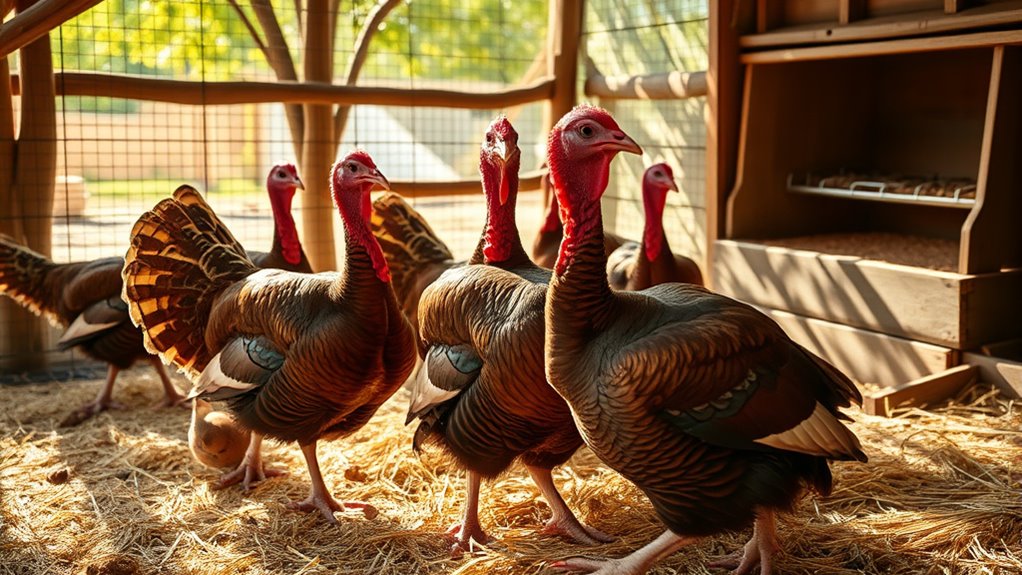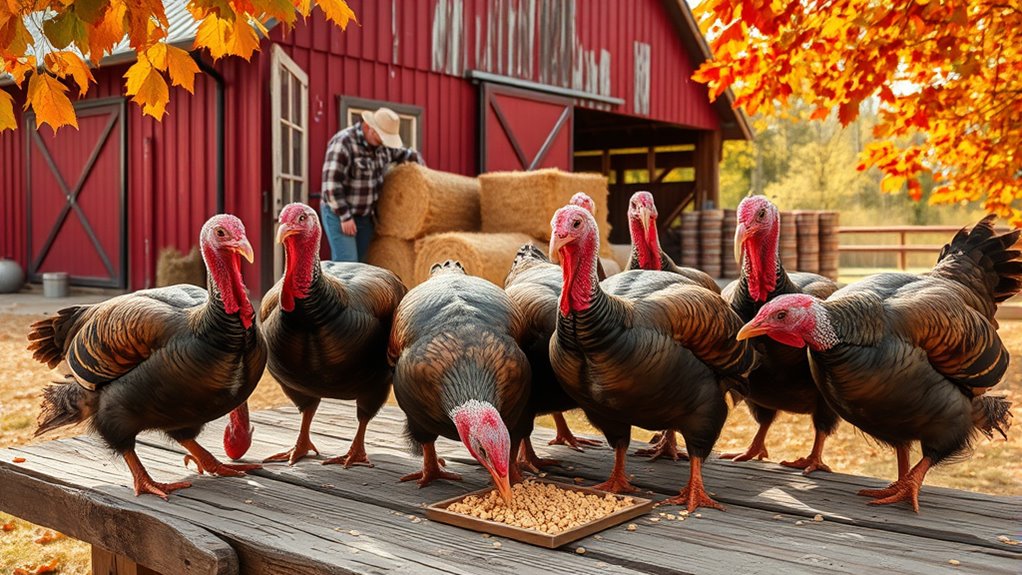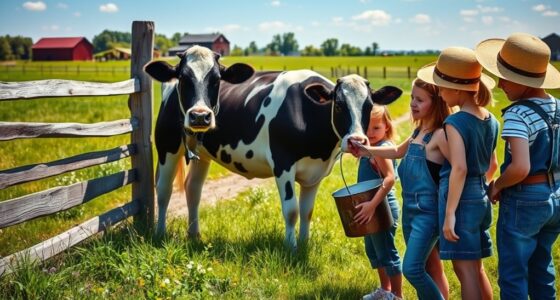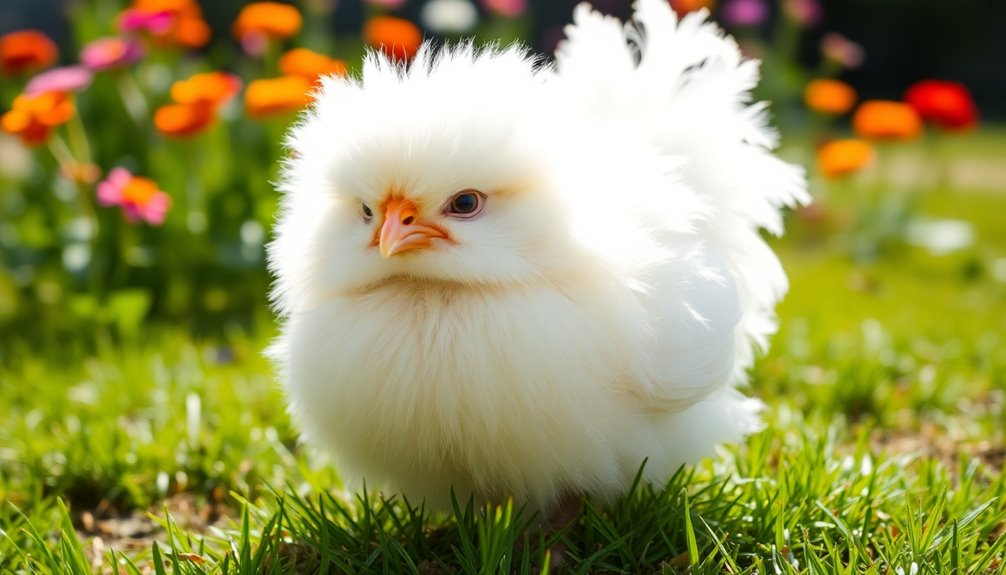To raise turkeys on your homestead for Thanksgiving, start by providing a balanced diet with commercial feed, greens, and clean water. Build a sturdy, well-ventilated coop with enough space and bedding to keep them comfortable. Give them outdoor space with shade and cover for foraging and exercise. Regular cleaning and attention to health guarantee your birds grow strong and flavorful. Keep learning more tips to make your homestead turkey project successful and stress-free.
Key Takeaways
- Provide a balanced diet with high-quality turkey feed, greens, and clean water for healthy growth and flavor development.
- Design a secure, well-ventilated coop with adequate space, sturdy walls, and comfortable roosts to protect and promote natural behaviors.
- Maintain cleanliness and hygiene regularly, ensuring proper ventilation and moisture control to prevent disease and respiratory issues.
- Offer a spacious outdoor area with natural cover, shade, and netting to allow for foraging, exercise, and predator protection.
- Plan ahead to monitor growth, ensure proper nutrition, and prepare turkeys early for a stress-free, successful Thanksgiving feast.

Raising turkeys on the homestead can be a rewarding experience, offering fresh meat and a satisfying connection to your food sources. To guarantee your turkeys thrive, you need to pay close attention to their turkey nutrition and create a well-designed coop. Proper nutrition is essential for healthy growth, especially as they approach Thanksgiving, when you want a robust, flavorful bird. Your turkeys require a balanced diet rich in proteins, grains, and essential vitamins. Commercial turkey feed is a good starting point because it’s formulated to meet their nutritional needs at various growth stages. As they grow, you can supplement their diet with kitchen scraps, greens, and grains, but avoid feeding them anything toxic, like spoiled food or certain weeds. Fresh water should always be available, as hydration impacts their overall health and growth.
Designing an effective coop is just as important as feeding them properly. Your coop should protect your turkeys from predators, harsh weather, and drafts while providing enough space for movement. A good coop will have sturdy walls, a secure door, and ventilation to prevent moisture buildup and respiratory issues. Turkeys are quite active, so aim for at least 4 to 5 square feet per bird inside the coop, with additional outdoor space if possible. Incorporate roosts at a comfortable height to encourage natural behaviors, and ensure there’s enough bedding—like straw or wood shavings—to keep them dry and comfortable. Proper coop design also involves easy access for cleaning and feeding, which helps prevent disease. Regular cleaning and inspection keep your turkeys healthy and reduce stress, which is vital when they’re preparing for Thanksgiving.
You should also think about their outdoor area, making it secure and spacious enough for foraging and exercise. Turkeys enjoy scratching and pecking, so providing a grassy yard with natural cover helps keep them happy and healthy. Covering part of their outdoor space with netting protects them from aerial predators like hawks and owls. When designing your coop and outdoor area, keep in mind that good airflow prevents respiratory problems, and shade helps keep them cool in hot weather. Planning ahead with a focus on turkey nutrition and sturdy coop design ensures your birds stay strong, healthy, and ready for Thanksgiving. With proper care, your homestead turkeys will develop the flavor and size you’re aiming for, making the holiday feast even more satisfying.
Frequently Asked Questions
What Are the Best Breeds for Homestead Turkey Raising?
When choosing the best breeds for homestead turkey raising, focus on breeding selection and heritage varieties. Heritage breeds like Bourbon Red, Narragansett, and Standard Bronze are excellent because they’re hardy, have good foraging ability, and produce flavorful meat. These varieties adapt well to your environment, require less specialized care, and help maintain genetic diversity. Picking the right breeds guarantees a sustainable, resilient flock for your Thanksgiving preparations.
How Do I Prevent Turkey Diseases Naturally?
Think of your turkeys as delicate flowers needing gentle care. To prevent disease naturally, focus on good hygiene, clean living spaces, and balanced diets. Use natural remedies like garlic and apple cider vinegar to boost immunity. Regularly monitor your birds for signs of illness and keep stress low. Preventing disease is about creating a healthy environment where your turkeys can thrive without relying on chemicals or antibiotics.
What Are the Ideal Turkey Feeding Schedules?
You should follow a consistent feeding schedule that meets your turkeys’ nutrient requirements. Typically, feed young turkeys 2-3 times daily, gradually reducing to 1-2 times as they mature. Guarantee the feed is high-quality and balanced for their age. Regularly monitor their intake and adjust feeding frequency as needed. Proper timing and nutrient-rich feed help keep your turkeys healthy and promote ideal growth.
How Can I Keep Turkeys Safe From Predators?
Think of your turkeys as treasures needing protection. To keep predators at bay, you set predator traps nearby, acting as vigilant guardians. Secure fencing acts as an unbreakable shield, enclosing your flock like a fortress. Regularly inspect and reinforce barriers, and remove any tempting gaps. With these measures, you create a safe haven where your turkeys can roam freely, shielded from harm, just as a sanctuary shelters its inhabitants.
When Is the Best Time to Process Turkeys?
You should process your turkeys when they’re around 16 to 20 weeks old, depending on their breed and size. Watch for signs like turkey molting, which can indicate natural growth stages, and observe turkey social behavior for stress or health issues. Processing after molting ends helps guarantee quality meat, and timing before winter begins can make handling easier. Always prioritize their health and natural cycles for the best results.
Conclusion
As you finish your turkey, it’s hard not to feel a sense of pride, especially knowing how much effort you put in from start to finish. On a chilly morning, you notice a flock gathering near your coop, as if they’re thankful too. That perfect, golden bird you raised isn’t just for Thanksgiving; it’s a reminder that with patience and care, your homestead truly becomes a place where abundance and gratitude naturally grow.










